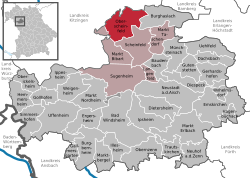Oberscheinfeld | |
|---|---|
 Market square | |
Location of Oberscheinfeld within Neustadt a.d.Aisch-Bad Windsheim district  | |
| Coordinates: 49°43′N10°25′E / 49.717°N 10.417°E | |
| Country | Germany |
| State | Bavaria |
| Admin. region | Mittelfranken |
| District | Neustadt a.d.Aisch-Bad Windsheim |
| Municipal assoc. | Scheinfeld |
| Subdivisions | 19 Ortsteile |
| Government | |
| • Mayor (2020–26) | Peter Sendner [1] (CSU) |
| Area | |
• Total | 42.27 km2 (16.32 sq mi) |
| Elevation | 331 m (1,086 ft) |
| Population (2023-12-31) [2] | |
• Total | 1,129 |
| • Density | 27/km2 (69/sq mi) |
| Time zone | UTC+01:00 (CET) |
| • Summer (DST) | UTC+02:00 (CEST) |
| Postal codes | 91483 |
| Dialling codes | 09167 |
| Vehicle registration | NEA |
| Website | www.oberscheinfeld.de |
Oberscheinfeld is a municipality in the district of Neustadt (Aisch)-Bad Windsheim in Bavaria in Germany.



